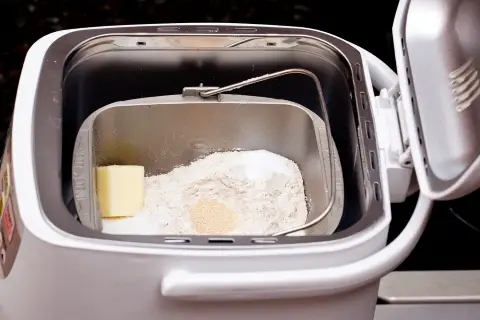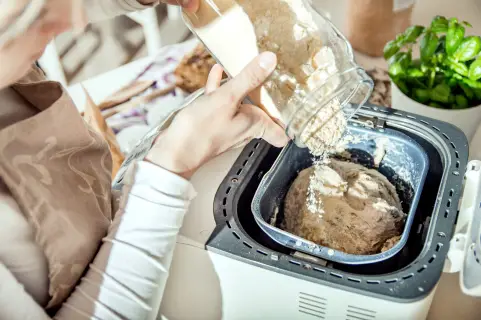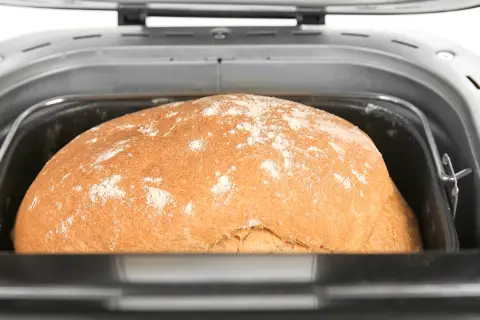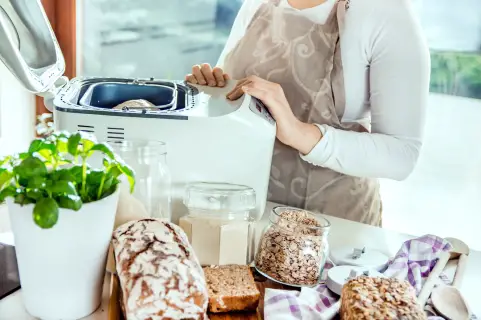Bread machines are remarkably easy to use. They consist of a removable pan used for baking and one or two paddles. The pan rests on the component that essentially bakes the dough, while the paddles are used to mix the ingredients thoroughly. This is achieved by spinning the paddles.
All bread machines feature different baking cycles. These baking cycles differ in the duration of each stage of baking the bread, the temperature, and the order of stages themselves. All these cycles are pre-programmed; hence they only require the addition of ingredients, and the machine will do all the work by itself once you’ve selected which cycle you want. This takes the guesswork out of making bread, which is what you’d have to contend with if you use a stand mixer instead.
Here are the bread machine dough cycle times explained and when each should be used.
Table of Contents
How Long do Bread Makers Take to Make Bread?
Why do bread makers take so long? Depending on the different bread machine cycles and the types of bread, bread makers will take varying amounts of time. The basic cycle used for making white bread will take an average of two to three hours. For more complex bread types like French bread, it might take almost four hours.
Bread machines also factor in the ingredients when taking their time to bake bread. Sweet bread with add-ins has a longer baking time while the absence of gluten in gluten-free flour significantly reduces the overall time and number of stages.
Why Are There Different Bread Machine Cycles?

Since bread machines can be used to make different bread types, they come with different bread cycles already programmed in them. This allows them to be used for all sorts of breads. For example, cinnamon bread has a soft and sweet flavor, while French bread has a rather crusty texture. The reason why bread machine cycles are different is due to the varying times taken for kneading, rising, and baking processes.
What Are the Cycles of a Bread Machine?
There are different cycles of a bread machine, each of them critical to the formation of good bread. The bread machine starts its process once you have put all the ingredients in and closed the lid. Most machines will beep at the end of the kneading cycle, the final rise cycle, and the baking cycle. These beeps are meant to remind you that if you want, it is time to add secondary ingredients, remove the kneaded dough or paddles, and remove the fully baked bread from the machine.
The first and arguably the most important step is the kneading cycle. During this cycle, all your ingredients are mixed together, making the gluten strong. This is what makes your dough have a good texture. If the dough hasn’t been kneaded properly, it will have a flat and tough shape instead of the light, airy one we need.
The type of bread you are making affects the duration of the kneading cycle. Typically the kneading cycle in a bread machine is around 20 to 40 minutes. Most bread machines will either get done with the kneading process entirely in one go, or they will allow a certain period for the bread to rest and rise, following which they will start the kneading process again.
Most bread machines are equipped with a paddle or two in the baking pan. These paddles keep spinning continuously to stir the dough thoroughly. This spinning of the paddles allows the dough to be moved around in the pan, kneading it all the way through.
You can check the dough by lifting the lid up during this stage but after this, it’s recommended that you don’t because you don’t want sudden temperature drops or loss of moisture during the resting, rising and baking cycles. Opening the machine after the kneading stage also creates the risk of the top of the loaf of bread collapsing.
The resting stage comes after the first kneading stage but before the second, depending on the type of bread machine you have. This step is important because the gluten and starch in your dough need to expand as much as possible and take in all the moisture. Absorbing the moisture reduces the time needed for the second kneading and also makes it much easier to handle the dough. The resting cycle has the added benefit of letting the dough obtain the optimum temperature level, should kneading be required again. The whole duration of the resting cycle will last anywhere between 5 minutes to 30 minutes.
During the rising cycle, the sugar is fermented by the yeast, which is necessary for the development of the dough. Assuming that your dough has gluten mixed in it, the yeast rising cycle is needed to make the dough airy and fluffy through rising. It also brings a lot of improvement in terms of flavor as well as the texture of the bread. The yeast ferments the sugar at a slightly warmer temperature. Hence, the temperature in the bread machine will be increased slightly. On average, the yeast rising cycle takes anywhere between 40 minutes to 50 minutes. The type of machine, along with the bread type, affects the duration of the rising. Be sure to use bread machine yeast and not regular yeast.

Once the rising cycle is over, the bread machine will then proceed to shape the dough. You may take the dough out of the machine at the end of the rising stage if you wish to finish off the shaping and baking in your oven.
Before the shaping starts is when you can add all your nuts and fruit if you want to. During the shaping process, the bread machine will restart its kneading stage. This is done to let out any gas bubbles that were formed during the yeast rising cycle. When all the gas bubbles have been released, the bread will have a much better quality of texture.
Shaping and kneading the bread at this stage generally takes not more than 10 seconds. The fluffiness and the airy quality have to be maintained. If the bread is punched too much, it will become flat and hard to eat.
The final stage is the baking cycle. Baking is done by heating up the pan to approximately 350 degrees Fahrenheit. The baking cycle usually lasts between 40 minutes to 70 minutes.
Bread Machine Programs for Different Types of Bread
The versatility of bread machines allows you to make different types of bread. However, each bread type will have different requirements and different cycle times.
The white bread cycle is the most commonly used cycle by everyone. This particular cycle gives you a lot of freedom to bake different types of foods like garlic, rye, potato, and wheat. The duration of this cycle is approximately 3 to 4 hours. The white bread cycle is as follows:
● First kneading stage – 5 minutes
● Resting stage – 5 minutes
● Second kneading stage – 20 minutes
● Rising stage – 39 minutes
● First shaping stage – 10 seconds
● Second rising stage – 25 minutes
● Second shaping stage – 15 seconds
● Third rising stage – 48 minutes
● Baking stage – 60 minutes
Sweet bread cycle is typically used for breads containing eggs, apricots, raisins, cinnamon, sugar, and fats. The sugar, along with other ingredients, gives your dough a brown color which is why the bread machine sets a slightly lower temperature for this cycle.
It is not recommended to use the basic cycle for the sweet bread as the bread will have a burned texture on the crust. The sweet bread cycle is almost identical to the basic cycle. The difference arises in the temperature levels being used. This cycle takes almost 3 hours and is as follows:
● First kneading stage – 5 minutes
● Resting stage – 5 minutes
● Second kneading stage – 20 minutes
● First rising stage – 39 minutes
● First shaping stage – 20 seconds
● Second rising stage – 25 minutes
● Second shaping stage – 5 seconds
● Third rising stage – 51 minutes
● Baking stage – 60 minutes

If you have breads that have a significant amount of whole wheat, buttermilk wheat flour, or cracked wheat, the bread machines will use the whole wheat cycle. Such breads require a lot more kneading and rising to produce the best quality of bread loaves. Similar to the previous cycles, there are three rising stages. However, the kneading time is considerably more in order to bake the dough properly.
● First resting stage – 25 minutes
● First kneading stage – 5 minutes
● Second resting stage – 5 minutes
● Second kneading stage – 15 minutes
● First rising stage – 49 minutes
● First shaping stage – 10 seconds
● Second rising stage – 25 minutes
● Second shaping stage – 10 seconds
● Third rising stage – 49 minutes
● Baking stage – 53 minutes
French bread has a relatively thicker crust. This is done by increasing the kneading, rising, and baking times. As there is a negligible amount of sugar, the dough will take more time to bake. Typically, the French bread cycle takes almost four hours.
● First kneading stage – 5 minutes
● First resting stage – 5 minutes
● Second kneading stage – 20 minutes
● First rising stage – 39 minutes
● First shaping stage – 10 seconds
● Second rising stage – 30 minutes
● Second shaping stage – 10 seconds
● Third rising stage – 60 minutes
● Baking stage – 55 minutes
For those people who are on a gluten-free diet, they will prefer to have their bread baked on the gluten-free cycle. The absence of gluten will significantly decrease the overall baking time, hence speeding up the kneading and baking stages. The entire gluten-free bread cycle takes about 2 hours. If you’re going to buy a new bread maker then make sure the model includes this gluten-free cycle because some of the cheaper models don’t.
● First kneading stage – 5 minutes
● Second kneading stage – 10 minutes
● Rising stage – 60 minutes
● Baking stage – 60 minutes
For those people who are in a hurry and can’t afford to spare a lot of time, the rapid bake dough cycle is perfect for them. This cycle takes under 2 hrs to complete. In this cycle, the duration of the kneading and rising stages is reduced. Ideally, whenever you are using a rapid bake dough cycle, you should be using rapid-rise yeast. There are only three stages which are as follows:
● Kneading stage – 20 minutes
● Rising stage – 18 minutes
● Baking stage – 42 minutes
Some machines that come with a rapid cycle use the highest power rating throughout the process so as to finish the task fast. This usually increases its total power consumption, so keep this in mind if you’re energy conscious. However, it would still be more energy efficient than an oven.


